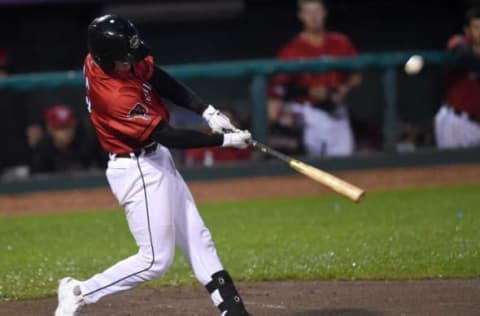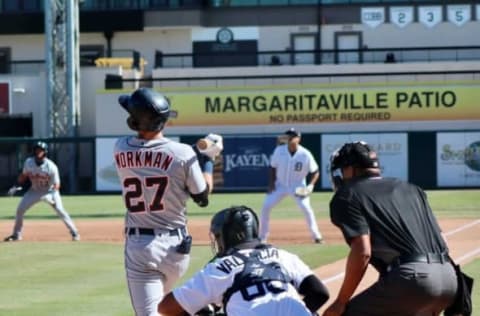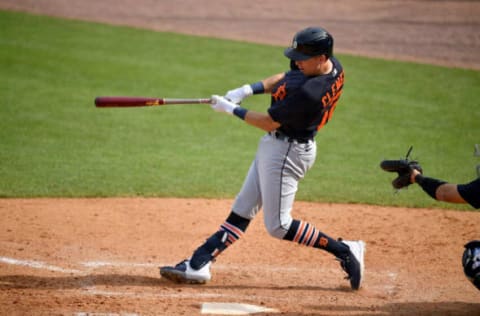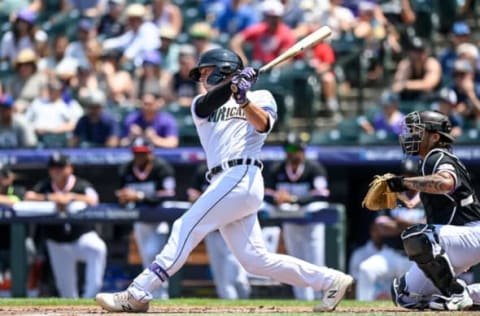Detroit Tigers minor league tools series: Best Power

Continuing our look at the top tools in the Detroit Tigers farm system.
This is the second of a dozen articles about the best individual player tools in the Detroit Tigers farm system — also known as The 12 Tools of Christmas. You can read about the best hitters in the system here.
Fans who found their Detroit Tigers minor-league coverage at TigsTown will be familiar with this format. We describe what we’re looking for in each tool, then list the five best examples in the Detroit Tigers system, along with a few honorable mentions, and young prospects who may climb the list soon. Let’s begin.
Detroit Tigers Minor League Tools Series: Best Power
A hitter’s power is often split into two categories: raw power and game power. Raw power essentially puts a grade on a player’s ability to hit the ball very hard and very far. Few things in baseball are more awe-inspiring than watching a hitter with 80-grade raw power send balls into low orbit during batting practice.
But batting practice power rarely translates into game power, and many players get branded with the pejorative “five o’clock power” label. Hitting live pitching is obviously much more difficult than blasting soft tosses from a coach, or even full velocity offerings from a machine. So most of our focus here will be on game power, with the occasional mention of raw pop.
We discuss power production in terms of home runs and extra-base hits, but also mention slugging percentage (total bases divided by at-bats) and isolated power (slugging percentage minus batting average). Last year the average MLB slugging percentage for non-pitchers was .418, while the average isolated power, or ISO, was .171.
Detroit Tigers Best Power Tools: Future Shock
- Cristian Santana – IF
- Jose De La Cruz – OF
- Adinso Reyes – IF
- Roberto Campos – OF
- Manuel Sequera – IF
Cristian Santana also made this list in our Hit Tool piece, and while he projects as more of a hitter for average than power, it’s hard not to include him here after he posted a .520 slugging percentage, a .251 isolated power, and 9 home runs as a 17-year-old in the Dominican Summer League. Since 2006 the only other Tigers 17-year-old to hit at least 9 homers in the DSL was Jose De La Cruz, who hit 11 in 2019.
It was a different story in 2021, though, as De La Cruz was severely overmatched in Low-A, hitting just .127 with one home run through 39 games. He was better after dropping back down to rookie ball, but his plus raw power won’t translate to game power without a dramatic improvement in his approach. Adinso Reyes had the same issues in rookie ball, but he did manage to go deep 7 times in 48 games.
The last two names on the list both came from the 2019 international free agent class. The enigmatic outfielder Roberto Campos got most of the publicity from that group, and it looked justified when he hit a home run on the first professional pitch he saw. It wasn’t always that easy for him, but he flashed plenty of his plus power over 39 games, finishing the season with an impressive .213 ISO and 8 home runs. But it was infielder Manuel Sequera who stole the show, blasting 11 home runs and 12 doubles in just 46 games. He’s another player with a concerning approach, but he was the only 18-year-old in affiliated baseball last year with an isolated power of .260 or better.
Detroit Tigers Best Power Tools: Honorable Mention

Dillon Dingler – C
For the first two months of the season Dillon Dingler looked like one of the steals of the 2020 MLB Draft. Through 32 games in High-A West Michigan and his first 12 outings with Double-A Erie, Dingler hit .287 with 9 home runs and 20 extra-base hits, which was good for a .251 ISO. But then the floor caved in, and he batted just .189 with a .081 ISO over his final 41 games. At his best, Dingler shows above-average game power and the ability to go out to all fields. That dramatic second-half swoon was most likely the result of injury and the rigors of being a regular catcher, but it was enough to keep him out of the top five this year.
I'll say it. Dillon Dingler is a DUDE.
— Dan Hasty (@ThatDanHasty) June 4, 2021
I'm fairly certain he hit this grand slam so far, it went into the future...
Alright, fine. Just 445 feet. pic.twitter.com/SrafVxPE1E
Reynaldo Rivera – DH/1B
If we only cared about raw power then Rey Rivera would be near the top of this list. He’s a massive human (listed at 6’6, 250) with equally massive pop, and when he connects the ball goes a very long way. Rivera hit 21 home runs in just 95 games, and in the process he tied the record for the most home runs in a season by a West Michigan hitter, and broke the record for the most career homers in a Whitecaps uniform. Unfortunately, Rivera hit just .207 last year, struck out in 37% of his plate appearances, and doesn’t add any defensive value. The door isn’t completely closed on him, but it’s unlikely Rivera makes much of an impact at higher levels.
106 exit velocity off the bat of Rey Rivera 💣💣 pic.twitter.com/WcdZahkPLj
— Tigers Minor League Report (@tigersMLreport) July 28, 2021
Detroit Tigers Best Power Tools: Numbers 5 and 4

5 – Gage Workman – SS/3B
With just 12 home runs last season, Gage Workman is the least prolific member of our top five in terms of over-the-fence power. But Workman has plenty of pop in the tank, with exit velocities in excess of 110 MPH last year, and multiple home runs that traveled more than 420 feet. Workman also tied for second in all of minor-league baseball last year with 37 doubles, and while he needs to continue to refine his approach, it’s not hard to envision more of those two-baggers clearing the wall in 2022. The switch-hitting Workman showed dramatic splits last year, with a .267/.349/.500 slash line as a left-handed hitter, but just a .179/.256/.226 line as a righty. If that keeps up he may simply abandon switch hitting altogether.
Gage Workman with a huge 3-run shot in the 8th to put West Michigan up 6-4. And it was an absolute 🚀 - one of the longest announcer @ThatDanHasty has seen at LMCU Ballpark. pic.twitter.com/NOyNQ1vnGm
— Tigers Minor League Report (@tigersMLreport) September 12, 2021
4 – Ryan Kreidler – SS/3B
When the Detroit Tigers drafted Ryan Kreidler in the 4th round in 2019 he was viewed as something of a glove-first prospect. That looked accurate in his first taste of pro ball, when he hit just .232 with 2 home runs in 60 games for short-season Connecticut. But Kreidler began defying those projections last March, when he used his few spring training at-bats to flash some impressive opposite-field power. That pop continued after his aggressive assignment to Double-A Erie, and it only improved after an August promotion to Triple-A Toledo. Kreidler finished the season with a solid .185 ISO and 45 extra-base hits, including 22 home runs — a modern record for a Tigers minor-league shortstop.
Kreidler’s swing is relatively short and simple, but he makes use of his long arms to produce plus raw power and spray home runs from pole to pole. He showed some weakness against premium velocity and quality breaking balls, so it’s probably best to project him for average game power now, but that’s more than just about anyone expected a few years ago, and good enough for him to rank fourth on our list.
Ryan Kreidler with a 3-run homer. His 19th of the year, and his 4th with Toledo. It’s 13-0 in the 2nd. pic.twitter.com/iMQUEEnDAJ
— Tigers Minor League Report (@tigersMLreport) September 12, 2021
Detroit Tigers Best Power Tools: Numbers 3 and 2

3 – Kody Clemens – 2B/RF
Detroit Tigers fans may have a bit of prospect fatigue when it comes to Kody Clemens. A 3rd round pick in 2018, Clemens turns 26 next May and was just added to the team’s 40-man roster last month. But his slow ascent to the big leagues might have obscured some real progress last season. Clemens kept his strikeout rate in a reasonable range (22.8%), showed better results against left-handed pitching (.796 OPS) than in 2019, and finally hit for the kind of power (18HR, .220 ISO) that got him drafted in the first place. Clemens is unlikely to hit for a high average, but he makes enough contact to take advantage of his above-average pop, and he can go deep to any part of the field.
The @MudHens offense is rolling.
— Minor League Baseball (@MiLB) September 5, 2021
Kody Clemens blasts a no-doubter for Toledo’s 5th homer of the day … and it’s only the 5th inning. pic.twitter.com/BB9qCpzySd
2 – Riley Greene – OF
Riley Greene graced the top of our best hitters list, and he comes close to the top of the power list too, thanks to his ability to make consistent, hard contact. Greene swings with the intent to do damage, and when he squares up the ball he does things few others can — this line drive double from spring training is the hardest hit by a Tigers batter since at least 2015. Greene can launch in any direction, against any kind of pitch, and against any kind of pitcher (he hit .368/.466/.574 against lefties last year). He’s bound to have some growing pains as he acclimates to MLB hurlers, but Greene has legitimate plus game power that should allow him to hit 20+ home runs annually, and 30 or more during his peak seasons.
You like watching Riley Greene hit home runs, yes? Well why not watch his first 20 homers of the year? 💣⬇️
— Tigers Minor League Report (@tigersMLreport) September 6, 2021
You’ll hear @Greg_Gania and @SabadosSports on some calls. pic.twitter.com/wcvXQ1dGiv
Detroit Tigers Best Power Tools: Number 1

1 – Spencer Torkelson – 1B/3B
Who else could it be? Spencer Torkelson is one of the most celebrated and prolific power hitters in college baseball history, and he brought that power bat with him into his first year of pro ball, blasting 30 home runs and another 29 doubles as he climbed from High-A West Michigan to Triple-A Toledo. Torkelson isn’t a physical marvel with otherworldly raw power like Giancarlo Stanton or Shohei Ohtani, but he does own legitimate plus-plus pop, and he gets to almost all of it in games thanks to a disciplined approach and a remarkably consistent swing. He will take early count strikes he can’t crush, and he lays off borderline offerings to get into favorable counts. Torkelson should threaten to hit 30+ home runs a year in the big leagues, and he may even hit 40 once or twice in his prime. He’s the best power-hitting prospect in the Detroit Tigers system, and arguably the best in all of minor-league baseball.
And there it goes! Spencer Torkelson with a monster blast to left center for his 30th home run of the season. Ties the game, too. pic.twitter.com/Jrxo5LvjYe
— Tigers Minor League Report (@tigersMLreport) October 3, 2021
Next. The lockout may cost MLB its young fans. dark